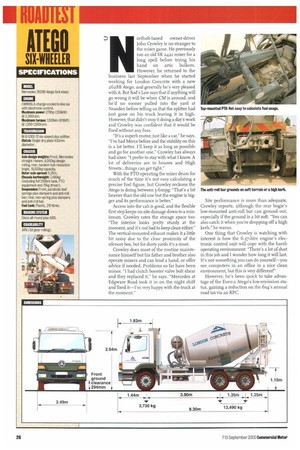Once upon a time the only mixer chassis in town
Page 26

Page 27

Page 28

Page 30

Page 31

If you've noticed an error in this article please click here to report it so we can fix it.
was the six-wheeler. But as construction customers demand bigger loads and mixer companies look for greater productivity, the eight-legger mixer is no longer a rare beast. CM has been out delivering with an Atego six and an Actros eight to get some concrete facts on how they perform.
VW eve long wanted to run an operational trial of a six and an eightwheel mixer. Unfortunately, its never happened because not every concrete com pany runs both types, or if they do not from the same manufacturer. Until now, that is—thanks to London Concrete and Mercedes we've finally got it sorted.
Cement mixers represent a speciality market—particularly the eight-legger. Of the 249 mixers registered during the first half of the year approximately a fifth were on four axles.
So someone must like them, not least the hundreds of owner-drivers who earn a living from them every day working for the big concrete producers.
Our trial procedure was simple. We met up with two of London Concrete's Neasden Plant-based owner drivers—one with an Atego 2628B 6x4; the other with the latest Actros 3235K 8x4—loaded up both and had a go behind the wheel to see how they deal with deliveries, before heading back to Neasden to discuss fuel economy and productivity with them and London Concrete's managing director, Derek Casey.
PRODUCT PROFILE
Merc's 26-tonne GVW Atego 2628B mixer chassis conies with a 6.37-litre charge-cooled six-pot pushing out 279hp at 2,300rpm and ntooNm of torque between 1,2500-1,5oorpm. Power is fed through to a 430mm single-plate clutch (slightly bigger than the standard tipper's) and then to M-B's own six-speed-plussplitter, overdrive top, manual synchro box with hydraulic assistance.
Behind that sits a two-spring, tandem-drive, hub-reduction bogie with a slightly deeper 5.26:1 ratio than the normal tipper's 4.83:1. If you want to climb every mountain there's even a 6.o:i duff but for regular town work we doubt you'll need it.
With an 8.o-tonne design rating on its straight-beam front axle, and 19 tonnes on the bogie, the Atego 2628B has a fair amount of loading latitude.
Inter-axle and cross-axle diff-locks are standard, as is a 210-litre plastic tank—on the tipper you get a 300-litre alloy one. To hold it back, Mere fits discs all round with ABS. Its big brother, the 32-tonne GVW four-axle Actros mixer, uses the hefty 3235K tipper chassis powered by the same r2-litre 354hp V6 as the Actros 1835 tractor.
It pumps out an impressive 1,730 Nm at just t,o8orpm, which is certainly a good deal for an eight-wheeler.
Behind its twin-plate clutch is M-B's r6speed range-change/splitter synchro box, but with a conventional manual shift (albeit with hydraulic assistance) in place of the tractor's EPS Telligent shift.
Bringing up the rear is the same two
spring hub-reduction tandem drive bogie, but with a 3.97:1 ratio, although M-B says alternative axle ratios may be available on request. While the Actros tractor has discs all round, the multi-wheeler rigid sensibly sticks to drums fore and aft.
If you expect the Atego to have a smaller cab than the Actros, then think again. Both feature a 2.49m full-width day cabin with a vertical exhaust
Our mixer mates were also fitted with a top-mounted, rear flange-driven power takeoff and London Concrete specifies every one of its wagons with Liebherr barrels—a 7tn3 unit on the six, and an eight on the 8x4, allowing loads of around 5.2 and 7.5rn3 of concrete respectively.
The only other noteworthy item is that our Actros eight-legger sported a set of smart Speedli tie alloy wheels to help keep its beefy kerbweight down to a minimum. How smart they'll be in a year's time remains to be seen. ortholt-based owner-driver John Crowley is no stranger to the mixer game. He previously ran an old 5K 2421 mixer for a long spell before trying his hand on artic bulkers. However, he returned to the business last September when he started working for London Concrete with a new 2628B Atego, and generally he's very pleased with it. But Sod's Law says that if anything will go wrong it will be when CM is around, and he'd no sooner pulled into the yard at Neasden before telling us that the splitter had just gone on his truck leaving it in high. However, that didn't stop it doing a day's work and Crowley was confident that it would be fixed without any fuss.
"It's a superb motor, just like a car," he says. "I've had Mercs before and the stability on this is a lot better. I'll keep it as long as possible and go for another one." Crowley has always had sixes: "I prefer to stay with what I know. A lot of deliveries are to houses and High Streets...things can get tight."
With the PTO operating the mixer drum for much of the time it's not easy calculating a precise fuel figure, but Crowley reckons the Atego is doing between 5-6mpg: "That's a bit heavier than the old one but the engine is bigger and its performance is better."
Access into the cab is good, and the flexible first step keeps on-site damage down to a minimum. Crowley rates the storage space too: "The interior looks pretty sturdy at the moment, and it's not bad to keep dean either." The vertical-mounted exhaust makes it a little bit noisy due to the close proximity of the silencer box, but for dusty yards it's a must Crowley does most of the routine maintenance himself but his father and brother also operate mixers and can lend a hand, or offer advice if needed. Problems so far have been minor. "I had clutch booster valve bolt shear and they replaced it," he says. "Mercedes at Edgware Road took it in on the night shift and fixed it—I'm very happy with the truck at the moment." Site performance is more than adequate, Crowley reports, although the rear bogie's low-mounted anti-roll bar can ground out, especially if the ground is a bit soft. "You can also catch it when you're dropping off a high kerb," he warns.
One thing that Crowley is watching with interest is how the 6.37-litre engine's electronic control unit will cope with the harsh operating environment: "There's a lot of dust in this job and I wonder how long it will last. It's not something you can do yourself—you see computers in an office in a nice clean environment, but this is very different!"
However, he's been quick to take advantage of the Euro-2 Atego's low-emission status, gaining a reduction on the 654's annual road tax via an RPC. D ust four weeks into the job and J
Mick Lavelle has hardly had time to form a solid opinion about his new 8x4 Actros. He believes it to be a good workhorse and with 14 years on the mixers, first with Murphys and then with Tarmac
Toprnix, it's fair to say he knows his subject.
Lavelle's recent move across the capital to London Concrete was made lightly. "When other drivers are doing well they are not slow to tell you about it,he says with a wry smile. Signing a five-year contract with London Concrete also meant a change of truck, transferring from a 6x4 Mercedes-Benz 2421 to the 8x4 Actros 3235K mixer. He has driven a variety of mixers in the past, including eights, but most of his work was done with a Merc six which, he believes, is "the best thing available for mixer work".
So was the move to driving an 8x4 daunting? "No, not really," he says. "The extra length and the wider turning circle makes it a bit tight at times; the six is more flexible. Occasionally you have to remind yourself that you are driving a longer, heavier and more powerful truck" The mixer is designed to London Concrete's specs so Lavelle had no choice over the type of truck on offer, but the more he uses the eight the more he is won over.
The major concern with all operators and owner-drivers is fuel consumption, and Lavelle is resigned to the fact that his is going to be heavy. He works and delivers within a 6.5km radius of Neasden, covering more than rookrn a day. He estimates that his fuel consumption is running at 4.254.50mpg but is always looking for ways to improve it. A local Esso garage was offering two pence off a litre of diesel, which saves a tidy sum when filling the tank.
The eight carries close to 8m3 of cement, which means he is likely to earn more money than 6x4 drivers by carrying more weight. However, it also means greater fuel costs and more wear and tear on tyres.
Storage space in the eight is the same as the sixes he has driven. His "office" for five-anda-half days only has to cope with a jacket, fuel receipts and delivery notes, possibly a lunch box and the hard hat. Over 14 years it's a small space that he has learnt to maximise.
Having bought a new truck Lavelle is happy enough to let the one-year M-B warranty handle any major disasters. He spent TI years maintaining his former secondhand truck and feels confident enough in his own ability not to pay for contract maintenance at boo per month: "I'll take a chance and put the money into an account. After two years you should have more than £7,aoo. Most basic things you can do yourself," he adds. Although tempting fate, Layette says there should not be too many problems with a new HGV.
To add to the splitter breaking on the six on CM's arrival, on the eight an air tank gauge broke causing the truck's computer to flash up a warning STOP. The tank had air in but you could riot help wondering about classic timing.
The impressively light steering when fully loaded makes it easy to flip the wheels around without realising it and this can cause extra wear and tear on the tyres. Lavelle says work sites are not always that accessible with an eight, even though most of his work involves bulk drops to major building developments.
Building sites are notoriously hard on the tyres. If you have to move backwards and forwards over short distances and move the wheels extensively to change the angle on harsh terrain, wear and tear or the chances of a burst tyre increase. "You have to be extra careful watching the sides as a new tyre can set you back," he says. The ground clearance of 353mm on the front with a straight axle and 3o3mm on the rear is ample but Lavelle points out that not all sites are as flat or as big as the one CM visited so pounding is inevitable.
• by Brian Weatheiley and Kevin Swallow
















































































































